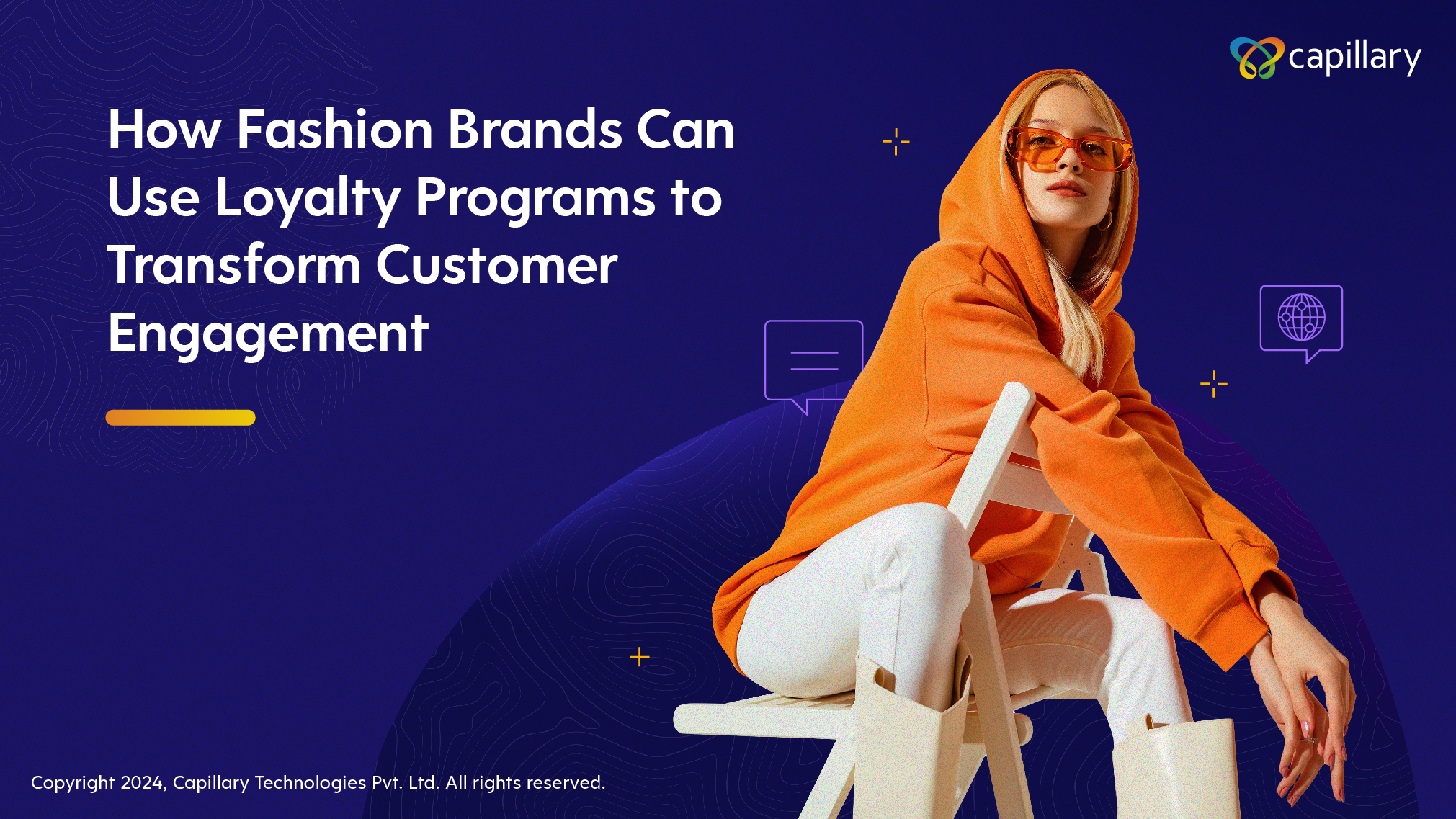- Design industry shaping loyalty programs
- Integrate easily and go live quicker
- Deliver hyper-personalized consumer experiences
Capillary acquires US-based Brierley+Partners Read more >
Capillary named a Leader in The Forrester Wave™: Loyalty Technology Solutions, Q1 2023 Report Read more >

At first glance, fashion – which is primarily driven by art, intuition and creativity- seems like an unlikely match for a clinical, analytical and logic-driven technology like Artificial Intelligence.
However, AI holds incredible promise for the fashion industry due to the massive data sets around historical style trends, sales patterns, market swings and customer preferences. For instance, did the global recession in 2009 impact people’s fashion sense and purchase behaviour? How about the Cold War? These are analysis that could yield interesting results and better yet, predict future behaviour and sales in response to global events.
Brands like H&M, Nike and Tommy Hilfiger are leading the way in leveraging AI-powered technologies to optimize the supply chain, enhance the in-store experience, and improve the overall customer experience. Merchandising teams are increasingly relying on data from stores, websites, mobile apps and loyalty programs to tweak designs and layer it with insights from social media, customer reviews and fashion forums to refresh the entire stock every few weeks.
In fact, the implications for AI applications in Fashion is so much that even tech giants like Google & Facebook are recognizing the massive opportunity. Facebook recently launched ‘Fashion++, an AI-powered fashion companion that helps you tweak your look. And Google teamed up with Versace to reinvent the famed JLo dress.
With annual spending in AI expected to hit $7.3 billion by 2022, it’s no surprise that AI is set to become an integral part of the apparel industry. Here are top impact areas that AI will likely have on the fashion industry :
In the last 20 years, fast-fashion brands like Zara and H&M disrupted traditional apparel market by shortening the design-to-store time from a few months to a few weeks and trading quality for lower prices and fresh stocks. However, this model requisites a deep understanding of current fashion trends, customer preferences, and the ability to predict where the market is headed. If not, they run the risk of unwanted inventory, discount sales and profit loss.
While demand forecasting techniques have been used to minimize the revenue loss, it was not always accurate as it solely relied on historical sales data and limited data sets. Machine Learning and AI technologies can incorporate learning from multiple sources and compute millions of data points to reduce demand forecasting errors by up to 50%.
The challenge so far in automating apparel manufacturing has been the inability of the robot to handle limp and flexible fabrics. However, Sewbo Inc., a Seattle-based startup found a fix by stiffening the fabric, thereby rendering it easier for the robots to handle the clothes. The startup recently launched its first robotically-sewn garment, which was crafted by a generic robotic system that was taught by Machine Learning algorithm on how to use a sewing machine. When coupled with accurate demand forecasting techniques, automated manufacturing has the potential to further shorten the design-store lifecycle down to a few hours!
One of the major concerns for fashion brands is helping customers choose the right fit and style without having to sift through thousands of products. Enter chatbots and digital stylists – customers can now chat/converse with these virtual assistants for getting style tips, finding the perfect dress for an occasion, getting the right fit/fabric based on their personal preferences or choosing a preferred delivery method. Expect this trend is set to take off, considering the rapid growth of smartphone and app adoption where the smaller real estate necessitates a more intuitive and faster product discovery.
Bombsheller, another Seattle-based apparel brand has started on-demand designing and manufacturing of clothes to a market of just one person. The company relies on a community of artists to submit designs using 3D modeling tools that create a photorealistic picture of how the finished product would look. The brand uses powerful software borrowed from video game engines to render the exact product as it will look even before a single stitch has been sewn. These ‘virtual’ leggings get uploaded to brand’s online catalogue. Once a customer hits “Buy,” the printer inks on the graphic design, and a seamstress cuts and sews the leggings. The finished product is then shipped out the next day. What makes Bombsheller unique is that they don’t spend a dime until a pair of leggings is sold. That translates to no dead inventory, no guessing market trends, no warehouse clearance and no loss of profits.
Using deep learning, Natural Language Processing and in-store analytics, the Smart Stores of the future will offer superior in-store experience by borrowing the best of personalization, customer engagement and CX practises from their online counterparts. Smart cameras and people counters powered by learning algorithms will offer accurate store insights about visitor demography, persona, sizing, product preferences, and online behaviour to help retailers stitch together a rich customer profile and hyperpersonalize the entire store experience. Several retail brands are experimenting with algorithms that predicts the most valuable customers who are likely to make repeat purchases based on previous in-store behaviour, loyalty earn/redemption rates and number of store visits. Other in-store applications of AI include identifying customer’s current fashion sense to make personalized recommendations , cashierless stores, monitoring shelf-life and freshness of perishables and interactive displays.
The Hong Kong Polytechnic University (PolyU) recently developed a smart fabric defect detection system, called “WiseEye”, which uses advanced AI and Deep Learning algorithms to help manufacturers instantly detect defects and anomalies in the production line. The system has been proven to reduce the chance of producing defective fabric by 90%, thus significantly reducing loss and wastage in the production.
Several brands are also experimenting with Machine Learning algorithms to find and filter fakes and counterfeit products. This technology is also used by customs and law enforcement officers to verify the validity of premium products like sunglasses and purses which are frequently counterfeited
Another trend that has been picking up steam of late is visual commerce. It essentially allows customers to take pictures of clothing they like or styles they want to imitate and find the exact items for sale. Additionally, AI-enabled shopping apps allow customers to take screenshots of clothes they see online, identify shoppable apparels and accessories in that photo, and then find the same outfit and shop for similar styles. For instance, if you have a specific patterned dress in your mind that your friend had worn at an event, AI can enable you to locate it. You can click a photo of your friend, upload it on a fashion site, and the AI algorithms will do the rest.
Nike has been the frontrunner in adopting technology to keep up with the changing times and stay ahead of the competition. In the last 5 years, the sports apparel giant spend millions on an acquisition spree of digital media, Ecommerce and analytics startups like Celect, Zodiac and Virgin MEGA to transform itself into a tech and data company that also sells fashion and apparel. When visitors walk into Nike Inc flagship store in New York and log into the app, the brand knows who they are, their shoe/apparel sizes, what sports they play and their favourite colours. Nike has reaped the benefits of its technology investments by reducing product defects, returns, shorter lead times, and most importantly, higher customer engagement and brand loyalty. The brand recently launched an app – Nike Fit – that offers “hyper-accurate” sizing recommendations for its shoes by scanning your feet with a smartphone camera.
H&M was one of the many brands whose sales took a severe wallop due to the retail apocalypse. The brand is now leveraging AI and Machine Learning to claw its way out of the slump and transform its business by spotting upcoming fashion trends, reduce unsold stock, optimize logistics and improve sales. The world’s second largest fashion group has started full-scale implementation of several pilot projects that were aimed at using data to match supply and demand as closely as possible. H&M is also harvesting data from loyalty cards and sales receipt to customize merchandise for an individual store. The brand recently teamed up with Google to create ‘Coded Couture’ , a cool app that creates a personalized design for every individual by analyzing their activities and interests over a period of one week.
Tommy Hilfiger partnered with IBM and Fashion Institute of Technology to help designers create new clothing line by analyzing customer sentiment around the brand’s apparel and imagery. The project was aimed at identifying key trends in silhouettes, cuts, patterns and styles that evoked positive customer sentiments by analyzing 15,000 images of Tommy Hilfiger products, 600,000 runway images that were publicly available and 100,000 patterns. Going forward, the brand plans to augment its design process with AI-powered insights to alleviates the pressure on the designer around creating a mass appealing creation.
In 2018, the UK-based online retailer developed an AI system to help customers find the right size of garment when shopping online. The smart fitting tool personalizes sizing suggestions based on multiple data sets like customer’s previous purchases and returns, as well as an optional set of questions based on height, weight and fit preferences. The online retailer rolled out the Fit Assistant across 200 markets and is available across ASOS collections, exclusive labels and fashion favourites. This year, the brand partnered with an AR startup to launch an augmented reality catwalk for users of its fashion app. The technology allows customers to view models as if they are walking in front of them by simply pointing their smartphone camera at any suitable flat surface and clicking the ‘AR’ button on the app.
Stitch Fix is a San Francisco-based fashion startup with a unique sales model. It combines the expertise of personal stylists with insights of an artificial intelligence system to analyze data on style trends, body measurements, customer feedback and preferences to deliver personalized apparel right to their customer’s doorsteps on a regular basis. Once the delivery is done, the customer can choose to keep all of the products or return what they don’t like or need. This input is fed into the company’s AI-powered data vaults to make the algorithms even better at determining the preferred style for each person and current trends. The brand also uses data to create its own designs known as Hybrid Designs. The system works by disassembling attributes of style such as color, arm length and neckline, etc. It then analyzes the feedback and customer sentiments available for each of these attributes and mutates them slightly to create new designs to share with human stylists.
While AI has proven its effectiveness in improving all aspects of fashion retailing, it’s impossible to remove the human factor from the equation. When they work together, the results are supercharged productivity, better customer engagement and higher profits. This trend clearly indicates the evolution of AI as an Augmented Intelligence rather than an Artificial one.

September 26, 2019 | 4 Min Read
At first glance, fashion – which is primarily driven by ar

March 7, 2024 | 4 Min Read
In the face of economic uncertainty and rapid technological